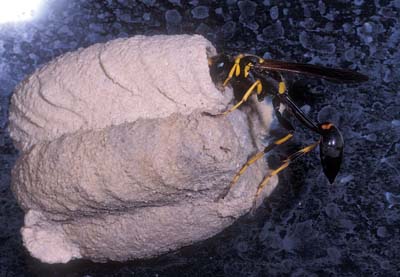
Adult Sceliphron caementarium, a mud dauber wasp.
(Photographer: Paul Choate, University of Florida)
Thread-waisted wasps range in color from blackish brown with yellow legs and clear wings to metallic blue with bluish wings. The common name for this wasp family refers to the very slender stalk or petiole that joins the abdomen to the thorax. The adults range in size from 1.2 cm to 4.0 cm. Some members of this group are known as "mud-daubers" because of their habit of constructing nests of mud on ceilings or walls of buildings. Other species are known by the prey items with which they are associated (e.g., cicada killers, bee wolves, spider wasps, weevil wasps).
Members of this large family (over 1,100 species in North America) are solitary wasps although a few species are eusocial, exhibiting primitive social organization. Most species nest in the ground but some build their nests in hollow plant stems, wood cavities or construct nests of mud. Females hunt for prey that serves as food for their offspring. The prey is stung to paralyze it and then placed in the nest where the female deposits her egg. The developing larva consumes the prey and then pupates in the nest. Some species are restricted to a particular prey item, which serves as the basis for the common names.
These wasps attack a wide variety of arthropods including grasshoppers, cockroaches, bugs, beetles, flies, caterpillars, spiders, and other wasps and bees.
Images
To save the Web-optimized images shown below to your hard drive:
|
Click to access Display and Print quality images. |
|
Click to access Display and Print quality images. |